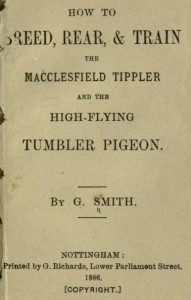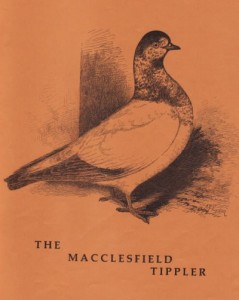by G. Smith, 1886 [Click Here for PDF Version]
The Macclesfield Tippler is a short faced bird, generally broad across the shoulders and rather short on the legs, most of them are mottled with dark flights and tail, these kinds of birds are favourites in the North of England and in the Potteries. From the appearance of the birds they have been bred from an Almond Tumbler and a Bald Pate, and are well known for their flying qualities, they will soar in the clouds and fly for hours. I have known them to fly twelve or thirteen hours at a time. Most of the Tippler fanciers in Congleton, Macclesfield, and the Potteries, only fly three birds together, and it is their study to fly three cocks that will work together. These birds should be all of one speed in flying, and if they are good they will work one against the other for many hours. When they have being on the wing seven or eight hours they fly very slow and careless and any one would think they were lost, for they wander about for miles. They fly in better style when they have been on the wing seven or eight hours than they do at the first starting.

These birds are not so large or strong as the long faced Tumbler, but by their steady flying, they will fly quite as long, in fact good birds will fly longer. These birds are fed on bread, white peas and barley, a change of diet is a great improvement, such as Indian corn, tares, or wheat, the latter will send them in the clouds till they are invisible, that is if it is a still clear day ; linseed, canary seed, and dari, will put extra life in them. A feed of bread once a week is very good and will regulate their bowels.
The Macclesfield Tipplers are not like the flying Tumbler, as they fly well in rough weather or smooth. A still sunshiny day is suitable for these birds, in fact it spoils their flight to put them out in windy weather. The best food for a long fly is bread, canary seed, millet, and rice, with canary seed tea to drink half an hour before rising them. These birds do not require any food which makes them fly quick, for the slower they fly the longer they will keep on the wing. Young Tipplers are very stupid till they are three or four months old. I have seen squeakers fly six and seven hours and not take any notice of other birds.

The old Tippler fanciers in Congleton and Macclesfield breed birds in one with another, that is, they breed from birds that are relatives of each other, such as father and daughter together. But it is my opinion the young ones they breed are anything but strong with being bred in this way. The Tippler has very broad flight feathers, and this is a great help to their flying qualities. They very seldom tumble, and a good Tippler should not show any signs of tumbling. The best food when training for a match is as follows: one week feed them on barley, second week feed them on dried wheat, peas, and Indian corn mixed together, linseed tea to drink night and morning. The last week’s training, in addition to their ordinary food, you must give them seed cake made in the same way as plum cake, but instead of currants put canary and millet seed in, also a small quantity of rape seed. This will make them strong and robust and make them fly longer. Feed them on their final fly with canary seed and rice, with a small quantity of Indian corn, give them canary seed tea to drink half an hour before rising them, this will improve their flying wonderfully. The spring of the year is the best time for Tippler flying but they will fly well all summer. These birds should not be flown too often or they will soon fail to fly the time expected. Every alternate day is sufficient, and if they are flying ten hours twice a week will be often enough. A week’s rest once in six weeks will give them every opportunity to get strong and healthy and full of spirit. Most of the best Tippler fanciers keep their birds up through the winter and a very good plan to, for dull misty weather will lose these kind of birds sooner than anything. This system is a very wise one as it does not only save them from being lost, but birds that are resting during the winter will fly better in spring. Good Macclesfield Tipplers will fly a very long time, that is if the place they drop on is low. High buildings near their settling place is a great disadvantage to Tippler flying as the birds are very likely to drop on it away from home, and if this occurs there will be no very long time done with them. A kit of birds that drop on high buildings will not fly so long by three or four hours as a kit that drops on a low building. A kit that drops on a high building will often sit out all day, and when this takes place they are more trouble than they are worth. It is a great difficulty to breed good Tipplers. It all depends how they are paired together. Birds slightly related will often breed good young ones. The best plan is to try the young ones the old birds breed, if they turn out good flyers let the old birds remain together, but if the young ones do not fly to satisfaction it is the best plan to separate the parents and pair them differently. The best time for flying in summer is first thing in the morning; good birds will fly all day, but I can assure my readers these long flyers are very scarce, and it takes a many years to procure them to perfection. The best plan is to get a few good birds and breed your own young ones from them. If you get a good breed of birds and have luck to breed some strong young ones from them you may by chance get a few of these extraordinary long flyers, but I can tell you that money will not buy them unless you are a great friend and the owner is giving up the fancy.
